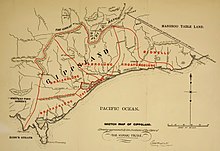Brataualung language
| Gunai | |
|---|---|
| Gaanay | |
| Kannai | |
| Region | Gippsland, Victoria, Australia |
| Ethnicity | Gunai people |
| Extinct | (date missing) |
| Revival | 21 (2006 census) |
|
Pama–Nyungan
|
|
| Dialects |
|
| Language codes | |
| ISO 639-3 | Either: unn – Kurnai ihw – Bidhawal |
| Glottolog | gana1279 |
| AIATSIS |
S68 Gunnai (cover term), S49 Bidawal |

Sketch Map of Gippsland - showing approximately the Positions of the Clans of the Kurnai Tribe.
|
|
The Gunai language (also spelt Gunnai, Ganai, Gaanay, Kurnai, Kurnay) is an Australian aboriginal dialect cluster of the Gunai people in Gippsland in south-east Victoria. Bidhawal (Birrdhawal) was either a divergent dialect or a closely related language.
Gunai means 'man'. The language had no traditional name, but each of its dialects was referred to separately.
In a 1996 report to the Victorian Aboriginal Corporation for Languages, Clark refers to five Gunai dialects: Brabralung, Braiakalung, Brataualung, Krauatungalung and Tatungalung.
Brabralung (Bra = man, lung = belonging to) located in central Gippsland.
Braiakalung (Bra = Man, ak = west, lung = belonging to) located around Sale through to the mountains.
Brataualung (men belonging to this place which have fire; Bra = men, Taua or towera = fire, lung = belonging to) located in South Gippsland.
Krauatungalung (Kraut = east, lung = belonging to) located east wards to the Snowy River.
Tatungalung (tat = sea, lung = belonging to) located in the coast area between Lake King and Lake Wellington.
Gunai dialects have been confused with Muk-thang/Bidhawal; there appear to be two distinct languages here, but it's not clear which variety belongs to which.
Like other Victorian languages, Gunai allowed initial l in its words. However, it also allowed initial rr, and well as the clusters gr (kr) and br (pr). This is quite unusual for an Australian language, and the same pattern was found in the Tasmanian languages across Bass Strait.
...
Wikipedia
